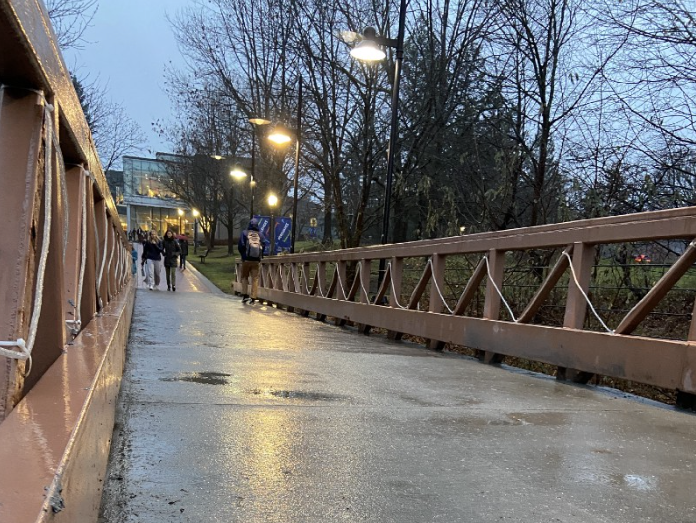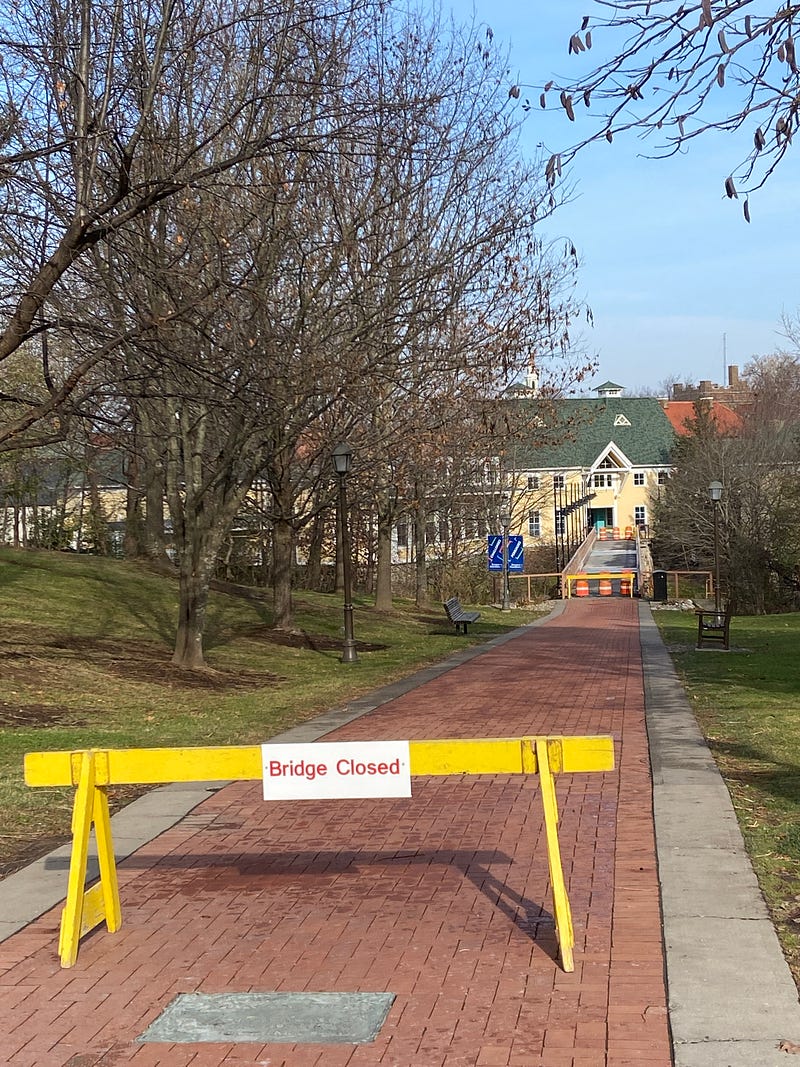
The Martin’s Way bridge was closed over Thanksgiving Break from Monday, Nov. 21 to Tuesday, Nov. 29, to fix major issues with potholes in the concrete. Mobility devices would often get caught by large potholes, causing falls, and students have been voicing concerns for years.
“This isn’t something we’re saying could be a risk, it’s something that has been proven to be a risk,” said Felix Tager ’23, who worked with Associate Vice President for Facilities and Planning Mike Klapmeyer to plan the bridge renovations.
Tager chairs the Student Assembly Residential Life and Safety Committee, which deals with infrastructure, residence halls, and substance use policies. The current iteration of student government, “is meant to mimic a committee system that was at Kirkland,” Tager explained. While Student Assembly (SA) committee membership is not limited to SA members, past committees have often been composed of a chair’s friends. This year there was a deliberate attempt to open up to more perspectives, so the Residential Life committee has ten members, including new freshmen and residential advisors, rather than the customary five.
Recently, the committee has mainly focused on accessibility issues, especially the “horrific” concrete degradation on Martin’s Way, Tager said. As an able-bodied person, he first spoke to the Disabled Students Network to get their perspective on which areas of campus needed the most urgent attention, such as the bridge and inaccessible curbs.
Klapmeyer, the head of Facilities Management, convinced the college to create a $500,000 yearly budget dedicated to accessibility. Plans for the near future include improving dining halls and adding an elevator to McEwen. Although the College is technically ADA (Americans with Disabilities Act) compliant, Tager emphasized that “ADA-compliant does not mean accessible, those words are not synonymous.”
Facilities rushed to fix the Martin’s Way bridge concrete during Thanksgiving Break, as it is a major traffic point and no renovations can be done once snow falls. More potholes still exist along the road, but the largest ones have been smoothed over with new concrete. However, it’s only a temporary fix. “We salt our ground so heavily that it causes those potholes, causing the ground to break down,” Tager explained.
In fact, the bridge will need to be rebuilt in the next few years because its supports are rusting. The College will need to decide whether to cover the bridge completely to eliminate the need for salt. Another idea, that Tager emphasizes is very tentative, is to heat the Martin’s Way sidewalk from underneath. It would be a large up-front cost, but “very cost-effective in the long term,” he said.

“There’s tangible change happening right now, but there’s other things that students have voiced concerns about that we’re trying to figure out how to address,” said Tager.
The Disabled Students Network has repeatedly pointed out that Martin’s Way is very slippery when it snows, and that the College should add a railing. Tager personally believes that “accessibility should come before the beautification of a campus, and the most important thing is people’s safety and ability to participate at college. Obviously.”
However, every major renovation requires Trustee approval to make sure the campus aesthetic is maintained. Trying to add a railing stretching the entire length of Martin’s Way means hiring an architect to design it. Even putting up a temporary railing isn’t allowed. “All these options will take time but they’re all being considered,” said Tager, so they’re focusing on quickly accomplishing the fixes that
can
be done.
While the College itself is inherently inaccessible due to its location in a hilly rural area, it’s important to do our best, he said.
Another recent project, headed by SA President Emily Jiang ’25, placed QR code stickers on all automatic doors, allowing students to report malfunctioning ones. Scanning the code automatically generates an email to Facilities, allowing them to quickly address the problem. Jiang collaborated with Facilities to implement their idea. “I thought of it in a meeting with Dean Card and President Wippman,” they said. When Dean Card mentioned that another institution had done a similar project, they realized that it could be a quick and easy fix to a common accessibility issue.
According to Tager, “working with people rather than working against them” is the secret to recent SA success. “The way these things get done is just having dialogues, to invite people to our meetings and not treat them like our enemy. The general perception of the Assembly is that we don’t want to work with the administration, and that’s really not true. We’ve had an incredible amount of productive dialogues this year to build relationships and find ways to get things done, and we’ve had a lot of change on campus.”
“Admin this year has been particularly responsive,” Tager says, “I’m trying to think of anything they said no to recently.” He credits this partially to having a new Dean of Faculty, Dean of Students, Dean of DEI, and Facilities. “I think that having these fresh perspectives is the perfect time for change to be made…they’re all looking at these issues with fresh eyes and are very driven.”
Each committee also has department heads as their advisors, and the Residential Life and Safety committee works directly with Director of Residential Life Ashley Place and Director of Campus Safety Frank Coots. Tager says that it’s “based on the Kirkland model of faculty and staff working together with students in a collective space to create policy.”
“Frank [Coots] is unbelievably receptive,” Tager said. The committee has been helping to revamp the campus safety website to make accessibility information easier to find, such as how to get an accessibility parking pass, get across campus with an injury, and how to access resources.
The committee is also working to change the parking ticketing system with Campus Safety. Building new parking lots is an expensive and difficult undertaking, but it’s important to make parking accessible for students in the meantime. “Whether we want to acknowledge it or not, tickets cost [a lot] of money and place a huge financial burden on students, especially those of low income,” Tager said. “We’re working on trying to make it so the first and second violations result in a training session that gives you guidance on where you can park.”
















